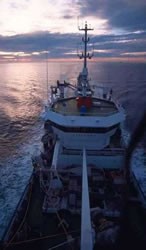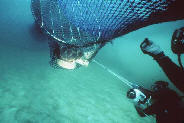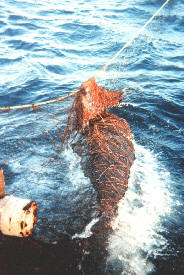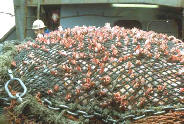EUROPEAN CETACEAN BYCATCH CAMPAIGN
"Man is but a strand in the complex web of life"
"Man is but a strand in the complex web of life"
There are two measures which could be implemented immediately and would reduce the levels of cetacean bycatch significantly.
http://europa.eu.int/comm/fisheries/doc_et_publ/liste_publi/studies/bycatch/contents.htm
Scientific studies have shown that a significant percentage of dolphins are caught between dusk and dawn. It has been suggested that this is due to the movements of the fish. During the day some pelagic species remain close to the sea bottom or in deep water.
Herring Stocks in the North Sea
At dusk, they move towards the surface, making it easier for the fishers and dolphins to catch the target species. Some scientists have suggested that dolphins prefer to forage at night as they do not have to share their prey with diving sea birds.
Given that pair trawl nets are fishing for 21 hours a day, it would not seem unreasonable to suggest that nets could be removed for a number of hours at night, to reduce cetacean bycatch.
However, this has been rejected by the fishing industry.
It has been suggested that vessels could reduce their engine size, and therefore the haul back speed, as this would reduce cetacean bycatch.
This has also been rejected by the fishing industry.
Contrary to statements made to the media by representatives of the fishing industry, scientists, the UK Minster for Fisheries and the European Commissioner for Fisheries acknowledge that pingers placed on trawl nets do not reduce cetacean bycatch.
SMRU (Sea Mammals Research Unit) was engaged to trial new mitigation measures involving the use of separator grids and an escape hatch for cetaceans.
The new gear was tested on a Scottish pair trawl, but no cases of dolphin bycatch were recorded.
This is not surprising given that the sea bass, a shoaling fish that swims with the prey species of cetaceans, had finished spawning in the area selected for the trials.
Consequently, less fish and therefore fewer dolphins in the trial area, plus a short trial period, would inevitably yield a skewed result.
The fishing industry appears to favour the trials of separator grids and escape hatches.
This is not surprising. The grids were designed to reduce fish discards without reducing catch levels, and are used or have been trialed in a number of fisheries, including mackerel fisheries.
Selection Girds - Internal grids - Marlab 4G.pdf
The development of the Eurogrid Whitefish Selector Grid involved 5 countries plus the EU Commission, and cost almost 2.25 million Euros.
Eurogirds - Whitefish Selective Grid Project - Marlab 07G-gridslite.pdf
Underwater video clips of © FAO
Diamond and square mesh codends in shrimp trawls
Nordmore grid that release fish
bycatch in shrimp trawls
Nordmore grid viewed underwater
Size selective grid for fish trawls
Selector grids have been useful in reducing fish discards, although they have been shown to damage a proportion of the target species.
They have also been useful in reducing turtle bycatch when used as Turtle Excluder Devices (TEDs)
However, dolphins have died in nets using TEDs.
Evidence from New Zealand suggests that these separator grids can, and do, harm marine mammals, when used as a bycatch mitigation measure.
http://europa.eu.int/comm/fisheries/doc_et_publ/liste_publi/studies/bycatch/contents.htm
Scientific studies have shown that a significant percentage of dolphins are caught between dusk and dawn. It has been suggested that this is due to the movements of the fish. During the day some pelagic species remain close to the sea bottom or in deep water.
Herring Stocks in the North Sea
At dusk, they move towards the surface, making it easier for the fishers and dolphins to catch the target species. Some scientists have suggested that dolphins prefer to forage at night as they do not have to share their prey with diving sea birds.
Given that pair trawl nets are fishing for 21 hours a day, it would not seem unreasonable to suggest that nets could be removed for a number of hours at night, to reduce cetacean bycatch.
However, this has been rejected by the fishing industry.
It has been suggested that vessels could reduce their engine size, and therefore the haul back speed, as this would reduce cetacean bycatch.
This has also been rejected by the fishing industry.
Contrary to statements made to the media by representatives of the fishing industry, scientists, the UK Minster for Fisheries and the European Commissioner for Fisheries acknowledge that pingers placed on trawl nets do not reduce cetacean bycatch.
SMRU (Sea Mammals Research Unit) was engaged to trial new mitigation measures involving the use of separator grids and an escape hatch for cetaceans.
The new gear was tested on a Scottish pair trawl, but no cases of dolphin bycatch were recorded.
This is not surprising given that the sea bass, a shoaling fish that swims with the prey species of cetaceans, had finished spawning in the area selected for the trials.
Consequently, less fish and therefore fewer dolphins in the trial area, plus a short trial period, would inevitably yield a skewed result.
The fishing industry appears to favour the trials of separator grids and escape hatches.
This is not surprising. The grids were designed to reduce fish discards without reducing catch levels, and are used or have been trialed in a number of fisheries, including mackerel fisheries.
Selection Girds -
The development of the Eurogrid Whitefish Selector Grid involved 5 countries plus the EU Commission, and cost almost 2.25 million Euros.
Eurogirds -
Underwater video clips of © FAO
Diamond and square mesh codends in shrimp trawls
Nordmore grid that release fish
bycatch in shrimp trawls
Nordmore grid viewed underwater
Size selective grid for fish trawls
Selector grids have been useful in reducing fish discards, although they have been shown to damage a proportion of the target species.
They have also been useful in reducing turtle bycatch when used as Turtle Excluder Devices (TEDs)
However, dolphins have died in nets using TEDs.
Evidence from New Zealand suggests that these separator grids can, and do, harm marine mammals, when used as a bycatch mitigation measure.
(Department of Conservation CSL 2000/2001 Contract: Autopsy of New Zealand sea lions incidentally caught in commercial fisheries: preliminary results of cover-net trials. Progress Report 16 July 2001)
Grids, similar to those recently trialed in European waters, and intended to reduce cetacean bycatch, were used in a New Zealand squid fishery, in an attempt to reduce sea lion bycatch.
However, the sea lions suffered severe injuries to their heads, chests, abdomens and flippers. As a result of the number of sea lion deaths, and the injuries sustained by those escaping through the hatches, the fishery was closed.
In the opinion of scientists in New Zealand, the sea lions, which did not drown in the nets, and managed to escape through the hatches, would not have survived due to their injuries.
In the opinion of the same scientists, marine mammal experts, the injuries sustained by cetaceans would be even more severe, and it would also be far more difficult to gauge the numbers of animals dying as a result of bycatch.
Perhaps this is the reason for the support given to the use of these grids by politicians and the fishing industry.
Grids, similar to those recently trialed in European waters, and intended to reduce cetacean bycatch, were used in a New Zealand squid fishery, in an attempt to reduce sea lion bycatch.
However, the sea lions suffered severe injuries to their heads, chests, abdomens and flippers. As a result of the number of sea lion deaths, and the injuries sustained by those escaping through the hatches, the fishery was closed.
In the opinion of scientists in New Zealand, the sea lions, which did not drown in the nets, and managed to escape through the hatches, would not have survived due to their injuries.
In the opinion of the same scientists, marine mammal experts, the injuries sustained by cetaceans would be even more severe, and it would also be far more difficult to gauge the numbers of animals dying as a result of bycatch.
Perhaps this is the reason for the support given to the use of these grids by politicians and the fishing industry.
Pair trawling will have a devastating effect upon populations of marine mammals, seabirds, turtles and sharks, and may well have the same environmental impact as large scale drift netting.
Pair trawling is considered to be so destructive that it is banned in a number of countries including Spain.
The European Cetacean Bycatch Campaign believes that all pair trawling in European waters should cease immediately.
All single pelagic trawlers should be monitored by independent observers in order to establish accurate cetacean bycatch figures.
A Cetacean Bycatch Response Team should then develop a Bycatch Response Strategy to reduce the number of cetaceans killed in pelagic trawl nets.
Top
Pair trawling is considered to be so destructive that it is banned in a number of countries including Spain.
The European Cetacean Bycatch Campaign believes that all pair trawling in European waters should cease immediately.
All single pelagic trawlers should be monitored by independent observers in order to establish accurate cetacean bycatch figures.
A Cetacean Bycatch Response Team should then develop a Bycatch Response Strategy to reduce the number of cetaceans killed in pelagic trawl nets.
Top



